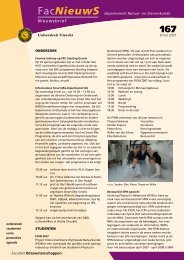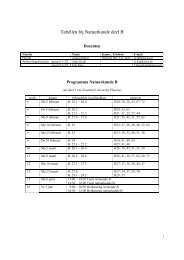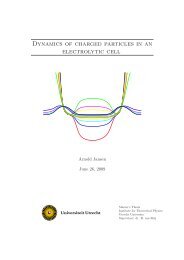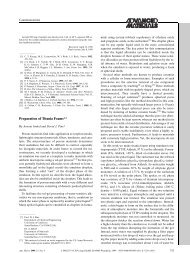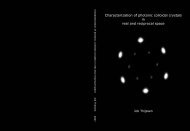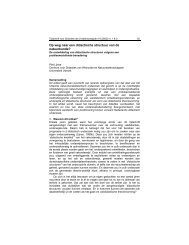Sedimentation Equilibrium of Mixtures of Charged Colloids
Sedimentation Equilibrium of Mixtures of Charged Colloids
Sedimentation Equilibrium of Mixtures of Charged Colloids
You also want an ePaper? Increase the reach of your titles
YUMPU automatically turns print PDFs into web optimized ePapers that Google loves.
their buoyant mass. The force that lifts the colloids against gravity is providedby an electric field that is induced by spontaneous charge separationover macroscopic distances. Although this phenomenon costs energy, the systemgains entropy because <strong>of</strong> a more homogeneous distribution <strong>of</strong> salt ions(and colloids). The same entropy-induced lifting force was recently found tobe responsible for a so-called Brazil-nut effect in binary mixtures <strong>of</strong> chargedcolloidal particles under low-salt conditions: the heavy particles can resideat higher altitudes than the lighter ones [15]. In this Letter we extend thetheoretical study <strong>of</strong> sedimentation <strong>of</strong> charged colloids to binary, ternary, andpolydisperse mixtures, for which we calculate colloidal density pr<strong>of</strong>iles andthe entropy-induced electric field selfconsistently within a Poisson-Boltzmannlike density functional theory.A.3 TheoryWe consider an n-component suspension <strong>of</strong> negatively charged colloidal spheresin a salt solution in the Earth’s gravity field. We label the colloidal speciesby i = 1, 2, · · · , n, and denote the electric charge, diameter, and buoyantmass for species i by −Z i e, σ i , and m i , respectively, where e is the protoncharge. We imagine the suspension to be in thermal and osmotic contactwith a reservoir that contains a solvent with temperature T , dielectric constantɛ, monovalent ions (charge ±e) at a concentration 2ρ s , such that theinverse Debye screening length is κ = (8πλ B ρ s ) 1/2 with λ B = e 2 /ɛk B T theBjerrum length. The ions are assumed to be massless point particles, andthe solvent mass density is taken into account by considering the buoyantinstead <strong>of</strong> the actual colloidal masses according to Archimedes. The volume<strong>of</strong> the suspension is V = AH, with A the (macroscopic) horizontal area andH the vertical height <strong>of</strong> the solvent meniscus above the bottom <strong>of</strong> the system.The gravitational acceleration g is in the negative vertical direction. We areinterested in the equilibrium colloidal density pr<strong>of</strong>iles ρ i (x) as a function <strong>of</strong>the altitude x above the bottom at x = 0 and below the meniscus at x = H.The ion density pr<strong>of</strong>iles are denoted by ρ ± (x). In order to calculate thesepr<strong>of</strong>iles we employ the framework <strong>of</strong> density functional theory [16], where theequilibrium density pr<strong>of</strong>iles follow from the minimisation <strong>of</strong> a grand potentialfunctional Ω[{ρ i }, ρ ± ] with respect to all the pr<strong>of</strong>iles. Here we employ themean-field free energy functional that consists <strong>of</strong> entropic, gravitational, and54



